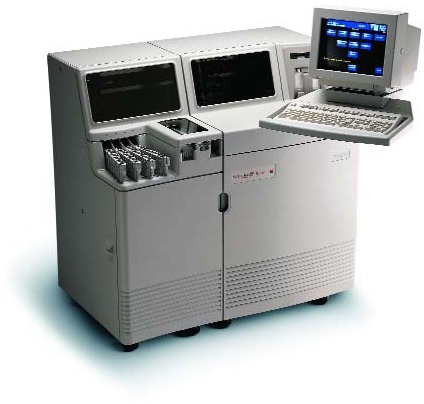Dry Chemistry:
The main principle of dry chemistry is based upon the reflectance spectrophotometry.
Reflectance spectrophotometry measures the reflectance of materials. Reflectance measurements are of great value in providing a reference standard for the comparison of the colour of different samples.
 |
| Fig. Vitros 250 Dry chemistry analyzer |
Reflectance measurements are made using both diffuse and specularly reflected light.In diffuse reflectance, light is scattered in all directions from the sample.Provided that this scattered light can be collected onto an optical detector, the surface reflectance may be measured either at a given wavelength, or by performing a scan over a range of wavelengths. Such a wavelength scan can then be used to characterise colour.
A reflectance spectrophotometer is similar to a standard UV/Visible spectrophotometer.It should have a bandwidth narrow enough to provide well resolved visible spectra yet wide enough to provide a good energy level for diffuse reflectance measurements. The reflectance spectrophotometer must also have optics and electronics systems of high sensitivity, and should be able to physically accommodate reflectance and transmission accessories. The adapted spectrophotometer must be able to make measurements both at selected fixed wavelengths or perform scans over the complete wavelength range.
In dry chemistry, slides are dry, multilayered analytical elements coated on polyester supports. A small amount of patient sample is deposited onto the slide and evenly distributed to all of the layers. The spreading layer contains the appropriate substrate and other components needed for the reaction. The analyte in the sample catalyzes the reaction sequence to yield products which absorb light at wavelengths in various regions (340 – 680nm), diffuses into the underlying layer, and is monitored by reflectance spectrophotometry. The test types are colorimetric, enzymatic end point, two-point or multi-point rate, or potentiometric. The rate of change in reflection density in converted to enzymatic activity or the amount of colored complex formed is proportional to the analyte concentration in the sample.
Specimen requirement:
2 ml of serum collected in a red top tube with a serum separator (gel barrier). Centrifuge the specimen after it has clotted to prevent hemolysis. Send to the lab at room temperature. If the blood is not sent to lab the same day it is drawn, centrifuge the specimen and refrigerate. Serum that is hemolyzed and/or lipemic may interfere with some chemistries and may be rejected.

No comments:
Post a Comment